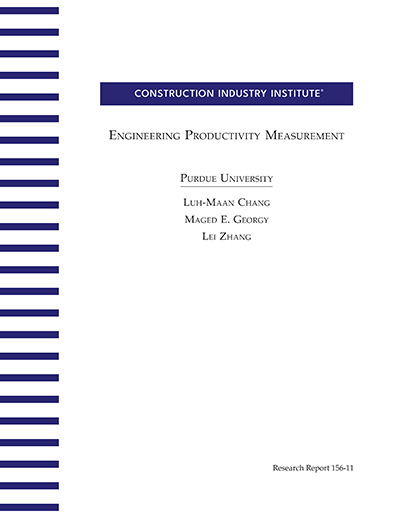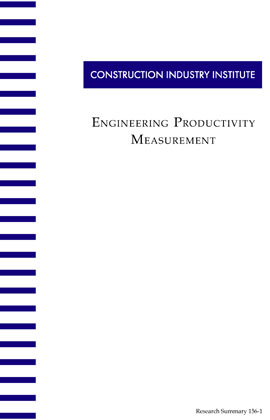
Engineering Productivity Measurement
Reliable Engineering Productivity Measurement is a critical element of predictable project performance and improvement. However, unlike Construction labor productivity, little work has been conducted in the arena of Engineering Productivity measurement. Engineering costs have steadily risen to levels approaching 20% of total project cost on Industrial projects. The effective delivery of engineering in the project cycle is a prime determinant of overall cost and schedule performance.
Industry standard productivity measurements must first be established, and then applied to present day work processes before significant improvement and predictability of performance can be made. Research Team 156 was established to better understand the present status of Engineering Productivity Measurement and to determine a valid measurement approach that will drive the improvement that present day design tools promise.
The research team concluded that a radically new model for measurement of Engineering Productivity that focuses on readily measurable, installed quantities is required. To be useful to the industry in driving continuous improvement, it is to be applied at the discipline level in the detail design phase of projects using influencing factors appropriate to project characteristics and industry sector. Expert opinion was used to propose the variables of interest for each discipline.
The measurement model concept was validated by conducting an in-depth study of the piping discipline in the heavy industrial sector. Collected project data supports the hypothesis that a correlation between installed quantities and hours spent on piping design exists.
In addition to this raw data, Influence factors for the Input Quality (Front End Loading), System Complexity, and Design Effectiveness must be developed. The model developed is similar to the software industry’s use of function point analysis. This model development is necessary since data that matches the model will be available only after its acceptance and use. The few companies that are presently using “installed quantity” data during the design phase of projects are using it primarily for detection of “scope creep.” Data collection efforts revealed that many companies are presently ignoring this readily available data.
The research team went one step further to address the interaction between engineering performance and its driving project variables by introducing a generic system that incorporated neurofuzzy computing with multiple attribute utility function. Neurofuzzy systems were used for relating the measures of engineering performance to the project input variables identified to have the largest impact on such performance. Multiple attribute utility function provided a collective evaluation of the total engineering performance.
The research products include:
- A thorough analysis of present state of engineering productivity methodology, with particular emphasis on the piping discipline.
- The application of learnings from other industries, especially the software industry’s use of function point analysis.
- Recommended installed quantity measures and disciplines which drive the engineering efforts with standard descriptions and discipline definitions required for uniform data collection.
- A measurement model framework that addresses all identified shortcomings with present methods, compliments present day work processes, focuses engineering resources on capital investment (installed quantities) and not solely on intermediate deliverables, and puts engineering and construction forces on an equivalent basis for project control purposes.
- Recommendation of initial influence factor assumptions and a data collection process to empirically refine the models for all disciplines into a uniform measurement system that will continuously improve with project usage.
The current engineering productivity systems most actively utilized in the industry are based on engineering deliverables, e.g., isometrics, P&IDs, etc. This has been driven by the pre-modeling era of project document generation.
RT-156 found that with the widely adopted 3D modeling execution, a better representation of engineering progress can be correlated with the engineering units, e.g., lineal feet of pipe, cubic yards of concrete, tons of steel, etc. (RR156-11, p. 87)


